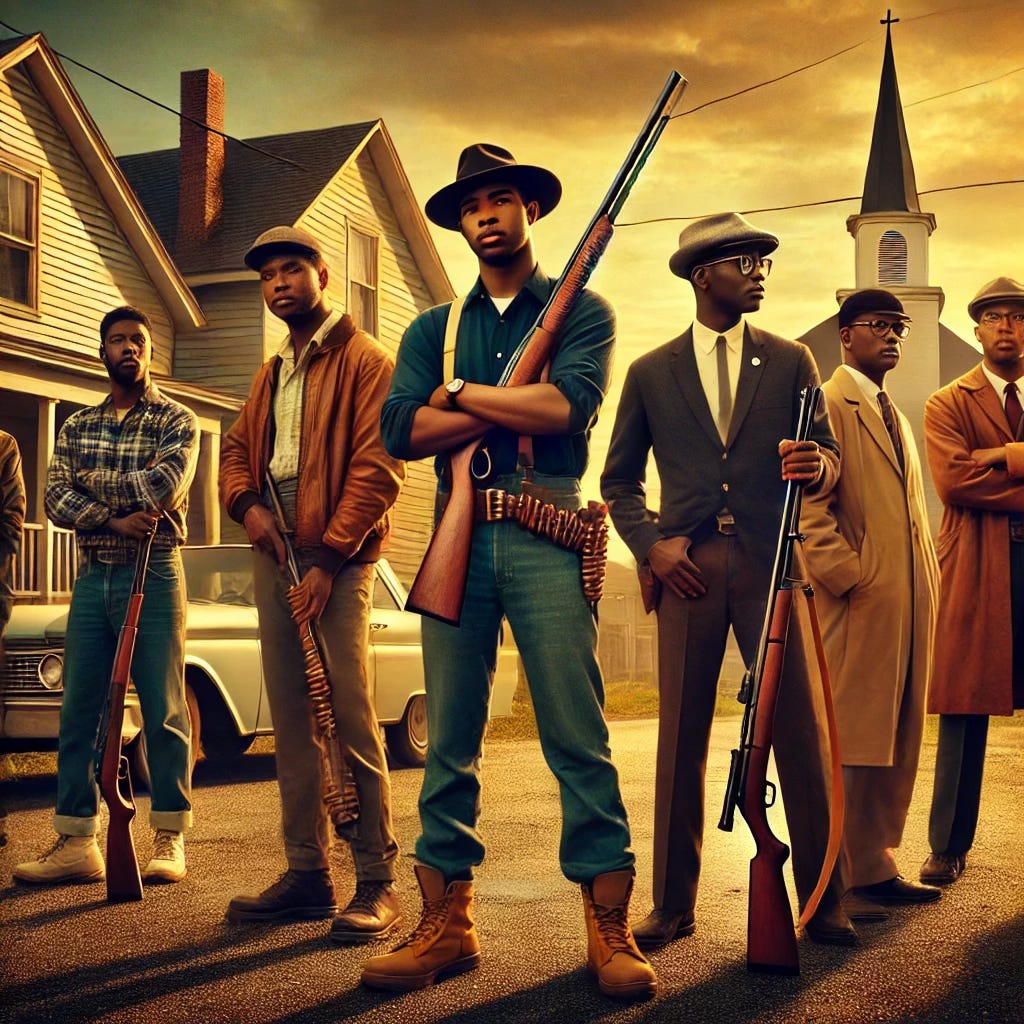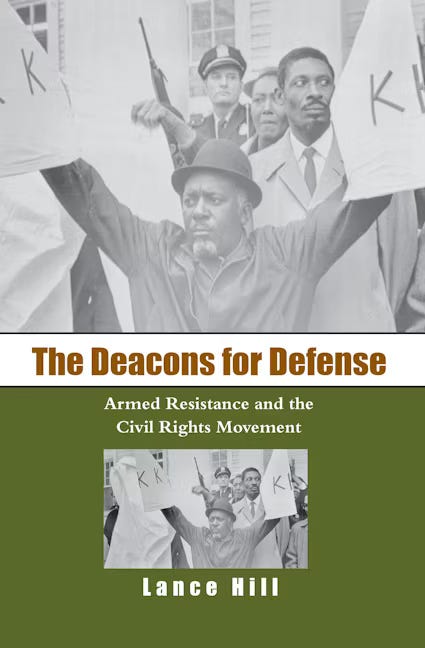The Deacons for Defense and Justice (1964): Protecting Black Communities from State and White Supremacist Violence
Black History Through The Lens of Liberation
During the Civil Rights Movement of the 1960s, when nonviolent protests dominated the public narrative, there existed another side of the struggle—one that didn’t get as much attention but was just as crucial. The Deacons for Defense and Justice, a group of armed Black men and women, was formed to protect civil rights activists and Black communities from the violence of the Ku Klux Klan and other white supremacists. Their story reminds us that liberation is multifaceted—it requires nonviolence, but it also requires defense.
The Deacons for Defense understood that self-defense wasn’t a betrayal of the movement but a necessary strategy to survive and sustain the fight for freedom. At a time when police officers often aided or ignored the actions of white mobs, the Deacons stood as a physical line of protection, prepared to defend their communities with their lives.
Why They Were Necessary: Fighting Violence with Preparedness
The Civil Rights Movement is often presented as a peaceful, nonviolent uprising, led by activists like Dr. Martin Luther King Jr. However, the reality is more complicated. Nonviolent protests regularly met violent opposition—activists were beaten, arrested, and sometimes killed while the state turned a blind eye. In many towns across the South, especially in Louisiana and Mississippi, the KKK terrorized Black families with impunity, burning homes, lynching Black men, and targeting those involved in the movement.
Local police forces weren’t protectors of justice; they were often enforcers of white supremacy. Black people couldn’t rely on law enforcement for protection, so they organized their own.
The Deacons for Defense and Justice were founded in 1964 in Jonesboro, Louisiana, by Earnest “Chilly Willy” Thomas and Frederick Douglass Kirkpatrick. Initially formed to defend local civil rights activists working with the Congress of Racial Equality (CORE), the group quickly expanded to other cities and became a nationwide symbol of armed resistance.
Reflection: What does it mean to create safety within a community when external systems fail or are actively harmful?
Who Were the Deacons?
The Deacons were primarily working-class Black men, many of whom were military veterans familiar with weapons and combat. They believed that their training and readiness were necessary to deter violence and protect their communities from the KKK’s reign of terror.
Armed with shotguns, rifles, and pistols, they didn’t go looking for fights, but they also didn’t shy away from confrontation when their communities were under threat. Their presence alone often discouraged violence. White supremacists who were used to terrorizing Black communities without consequence were suddenly met with armed, organized resistance.
One of the most significant moments for the Deacons came during the 1965 March Against Fear in Bogalusa, Louisiana. When civil rights activists were repeatedly threatened and attacked, the Deacons provided armed security, ensuring the march could continue.
Reflection: How do marginalized communities today create protective systems in the absence of reliable state support?
The Balance Between Nonviolence and Self-Defense
The Deacons for Defense didn’t oppose the nonviolent strategies of the broader Civil Rights Movement, but they recognized the limitations of nonviolence when facing unchecked brutality. Their role was to complement peaceful protests by ensuring that activists had a line of defense when the state failed to protect them.
This balance is a critical lesson for modern movements. Nonviolence can be a powerful tool for change, but it doesn’t negate the need for safety and protection, especially when marginalized communities are under threat.
The Racist History of Gun Control in the United States
Gun control in the United States didn’t originate from concerns about public safety—it originated as a tool of racial control. Since the earliest days of this country, laws regulating gun ownership and carrying have disproportionately targeted Black people.
Slave Codes: Enslaved Africans were prohibited from owning firearms to prevent rebellion and self-defense. Even free Black people were denied the right to bear arms as a measure of social control.
Black Codes (Post-Civil War): After the abolition of slavery, Southern states enacted Black Codes that included restrictions on gun ownership for newly freed Black people. These laws were designed to maintain white dominance and prevent Black communities from protecting themselves from white violence.
The Mulford Act (1967): One of the most explicit examples of racialized gun control came in response to the Black Panther Party’s open carry patrols. The Panthers famously patrolled neighborhoods while armed, monitoring police interactions to ensure accountability. Their legal use of firearms sparked fear among white lawmakers, leading to the Mulford Act in California, which banned the open carry of loaded firearms. Then-Governor Ronald Reagan signed it into law, explicitly targeting Black activists.
The history of gun control in this country shows that its primary goal has not been to protect public safety but to disarm marginalized communities and prevent them from defending themselves against state-sanctioned violence. Today, conversations about gun rights often ignore this history and center white fear, while Black gun owners continue to face disproportionate scrutiny and criminalization.
Reflection: How can we reframe the conversation on gun rights by acknowledging its history of racial control and ensuring marginalized communities have access to self-defense?
The Impact of the Deacons
The Deacons for Defense inspired other groups to adopt self-defense as part of their liberation strategies, laying the groundwork for organizations like the Black Panther Party. They demonstrated that Black communities didn’t have to passively endure violence—they had the right to protect themselves.
Their efforts also exposed the hypocrisy of a system that criminalized Black self-defense while ignoring white violence. By asserting their right to bear arms and protect their families, the Deacons challenged the narrative that only white citizens could exercise that right.
Why Their Story Still Matters
The Deacons for Defense show us that liberation is not a one-size-fits-all approach. Nonviolent protests, legal action, and self-defense can coexist within the same movement, each serving a unique purpose. Today, as Black communities continue to face state-sanctioned violence, police brutality, and systemic oppression, the Deacons’ legacy offers guidance on how to protect and uplift each other.
Their story is a reminder that creating safety isn’t just about waiting for external protection—it’s about organizing, standing together, and being prepared to defend what we’ve built.
Reflection: Can we truly achieve liberation without self-defense as part of our strategy?
In today’s context, where we see police violence, far-right extremism, and systemic injustice, how can communities organize to protect themselves without relying on systems designed to harm them?
Actionable Step:
Learn about local mutual aid networks or community defense groups. How can you support their efforts or create similar structures in your community?
A 28-Day Journey Through Black Resistance and Liberation
The story of the Deacons for Defense is one of many lessons featured in my 28-Day Journey Through Black Resistance and Liberation. This living document is continuously updated with stories like these—stories that center Black resilience, self-determination, and community care.
Join the journey today: Link to Lesson Plan
In solidarity and liberation,
Desireé B. Stephens CPS-P
Educator | Counselor | Community Builder
Founder, Make Shi(f)t Happen







This and The Color of Law. How was/is all this possible? This is America. They can’t just make laws handicapping just certain people. Laws are for everyone. I just can’t with this country any more.